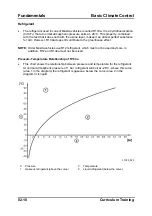
Basic Climate Control
Fundamentals
Cooling the Air in the Vehicle
•
The example of the cold glass of water can be partially compared to the evaporator. The
evaporator is filled with a cold liquid, and this liquid absorbs the heat from the air as it
comes in contact with the fins of the evaporator. The heat travels from the hot air to the
cold evaporator.
L1005_003
1 Warm
air
3 Evaporator
2 Cold
air
•
This heat absorption process in the evaporator is a little more complicated than the
heating process in the heater core. As the refrigerant passes through the evaporator, it is
a low pressure, cold liquid. As the warm air comes in contact with the fins of the
evaporator, the heat from the warm air is conducted through the metal fins and warms
the refrigerant flowing through the internal passageways. This warmth causes the
refrigerant to boil. During this boiling process the heat energy from the hot air entering
the vehicle is transferred to the refrigerant.
•
As the refrigerant leaves the evaporator is will be a low-pressure gas. The heat energy
absorbed was used to change its state from a liquid to a gas (to boil it). The end effect
for the air is that as it comes out the other side of the evaporator it is now colder. The
two physical principles that allow this are the
latent heat of vaporization
, and the
pressure-temperature relationship
properties of the refrigerant.
Curriculum Training
02-5
Summary of Contents for CT-L1005
Page 1: ...Training Manual Basic Climate Control CT L1005...
Page 20: ...Fundamentals Basic Climate Control Notes 02 14 Curriculum Training...
Page 52: ...A C System Basic Climate Control Notes 03 32 Curriculum Training...
Page 66: ...List of Abbreviations Basic Climate Control Notes 06 2 Curriculum Training...












































